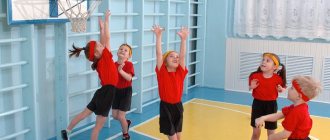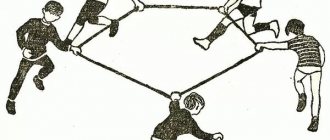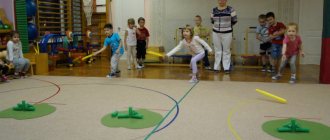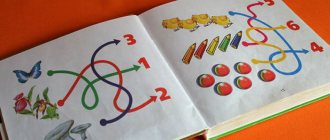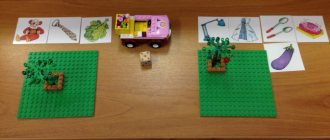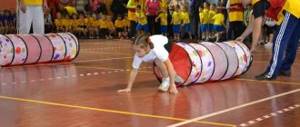COMPETITIONS FOR THE “FUN STARTS” RELAY
COMPETITIONS FOR THE “FUN STARTS” RELAY
Fun starts are a variety of sports competitions for teams. The tasks depend only on the imagination of the organizer and the children's capabilities.
Goal: organizing leisure time for students, developing physical education, recreation and sports activities at school.
Tasks:
- Uniting students.
- Development of physical qualities.
- Promotion of healthy lifestyles.
- Involving schoolchildren in physical education and sports.
Venue: gym, sports ground.
1
Relay race “Passing the baton” .
The teams are lined up in columns, one at a time, behind the starting line, with the relay baton in the hands of the leader. At the signal, the first number runs to the chip, runs around it and returns to the team, passing the stick to the next one. The second one performs the same task, etc.
Inventory: sticks.
2
Relay race “Crossing with a hoop” .
All participants line up in a column. The first player puts on the hoop. At the signal, he runs to the chip and back, then puts the hoop on the second participant and runs with him in the hoop to the chip. The first participant remains on the opposite side of the court, and the second runs after the third, etc. Once the last player has been "transported", the teams must form columns.
Equipment: hoops.
3rd
relay race “Kangaroo”.
The first participant, holding the ball between his legs (above the knees), must move forward by jumping to the chip and back. When you return, pass the baton to the next player. If the ball falls on the floor, you need to pick it up, return to the place where the ball fell, hold it with your feet, and only then continue the relay race.
Equipment: balls.
4
“Pass it on” relay race.
The teams line up in columns, the first player receives the ball. At some distance in front of each team, a hoop is placed into which the player throws the ball. The second team member catches the ball, while the first takes a place at the end of the column. If the ball is not caught, then the third player runs after it. Next, the second player throws the ball. The team that gets the ball back to the first player the fastest wins.
Equipment: balls and hoops.
5
“Wave” relay race.
The teams line up in parallel, the players on the team stand in a column behind each other’s heads at a distance of one step from the other. The first numbers in the teams place the ball in front of them so that they can take one step to reach it. At the signal from the leader, the first number, leaning forward, takes the ball with his hands, lifts it above his head, and, leaning back as far as possible, passes the ball to the second number of the team standing behind him. The second number, leaning forward, receives the ball and passes it back through his widely spaced legs. The third number passes the ball like the first, the fourth - like the second, the ball travels along the line of players alternately: above the head - under the feet, above the head - under the feet, making wave-like movements. The winner is the team that, without making a single mistake or dropping the ball, can quickly pass the ball from the first number to the last.
Equipment: balls.
6
Relay race “Carrying three balls” .
At the start, the first participant in the relay takes three basketballs at once and, at the leader’s signal, runs with them to the landmark (hoop). Leaves them there, runs back and passes the baton to the next participant. He must deliver the balls back to the starting line. And so on.
Equipment: hoops and balls.
7
Relay “Volleyball relay” .
Teams choose captains. On the site, two parallel lines are drawn at a distance of 3 meters: teams line up behind one, captains stand behind the other, each facing their team. The captains each have a volleyball in their hands. At the signal, the captains throw the ball to the players in front of their teams. Having caught the ball, the player throws it back to the captain and takes his place at the end of the column. Then the captain throws the ball to the second player and, having received it back, to the third and so on in order. After passing the ball to the captain, each player runs to the end of the column. The relay ends when the first person to catch the ball thrown by the captain is at the starting line.
Equipment: volleyballs.
8
Relay race “Agility football player”.
From the starting line, players dribble the soccer ball with their feet in a straight line to the hoop, circle it and return back, also dribbling the soccer ball with their feet in a straight line. At the starting line, the ball is passed without using the hands. The next team member cannot start the relay until the previous player crosses the starting line.
Equipment: soccer balls and hoops.
9
Relay race “ Running with a skipping rope ”.
At the judge's signal, the first member of each team jumps over the rope for each running step from stand to stand. The player then runs to the hoop and places the jump rope in it, runs around the hoop and returns to his team as usual. The baton is passed by touching the hand of the second player. The second player starts the relay with a regular run, runs up to the hoop, takes the jump rope and returns with jumps for each step from rack to rack, then runs to the starting line and passes the baton. Children must complete the task “jumping rope for each running step” from the starting line to the counter. If a player violates the terms of the relay, he is returned by the judge back to the starting line to perform the relay correctly.
Equipment: jump ropes and hoops.
10
Relay race “Crossing the swamp”.
The first participants each have 2 pieces of paper. The task is to go through the “swamp” by stepping on “bumps” - sheets of paper. You need to put a “bump” on the floor, stand on it with both feet, and put the other “bump” in front of you. The winner is the team that passes the “swamp” first.
Inventory: A4 sheets of paper.
The advantages of relay races: brightness, dynamism and entertainment; short duration; versatility in terms of site; does not require special physical training; easily adapts to any number of participants; extraordinary format; positive atmosphere.
The number and type of tasks that make up the relay race vary depending on the specific tasks and conditions of the event. A team game involves an almost unlimited number of teams and participants from 10 to 1000 people.
Relay races for children, material on the topic
Games - relay races - are a type of sports games in which participants take turns performing some action, and each participant, having completed his stage, passes the “move” to the next player.
Relay games develop children's physical abilities: running speed, agility, strength, endurance, reaction speed, coordination of movements. In addition to the benefits for the child’s physical health, relay races are useful because they teach children to work and interact in a team, coordinate their actions with friends, and jointly achieve a goal. Participation in team relay games is very useful for shy and unsociable children. Such children have difficulty speaking in front of other people and often refuse games where they can be the leader or the loser because they are afraid of excessive attention to themselves. Participation in team play gives them confidence, helps them overcome their fears and gives them the opportunity to socialize and play with their friends.
Relay games belong to the category of team outdoor games with given rules. All children are divided into two or more teams, and the teams compete with each other. Each team selects a captain who coordinates the participants and ensures that the rules are followed in his team.
The main element of any relay race is covering the allotted distance by running or other means of movement and completing some task. Simple relay races for preschoolers involve only covering a distance or covering a distance and performing some task (throwing a ball, climbing or jumping over obstacles). Relay races for older children can be more complex and include 2-3 types of additional tasks.
Before the start of the game, all participants line up in a column one after another. On command, the first players in each column begin to move. Each participant who has completed the relay stage gives the right to participate to the next player by handing him an object or touching it with his hand. The game continues until the last participant completes the task. The team whose members finish the relay first is declared the winner.
In the swamp.
Two participants are given two sheets of paper. They must go through the “swamp” along “bumps” - sheets of paper. You need to put the sheet on the floor, stand on it with both feet, and put the other sheet in front of you. Move to another sheet, turn around, take the first sheet again and place it in front of you. And so, who will be the first to cross the room and come back?
No worse than a kangaroo.
You need to jump a certain distance, holding a regular or tennis ball between your knees. If the ball falls to the ground, the runner picks it up, pinches it again with his knees and continues jumping.
Baba Yaga
Relay game. A simple bucket is used as a stupa, and a mop is used as a broom. The participant stands with one foot in the bucket, the other remains on the ground. He holds the bucket by the handle with one hand, and a mop in the other hand. In this position, you need to walk the entire distance and pass the mortar and broom to the next one.
Pass by, don't touch me
On level ground, at a distance of a step from each other, 8–10 towns are placed on the same line (or pins). The player stands in front of the first town, is blindfolded and asked to walk back and forth between the towns. The one who knocks down the fewest towns wins.
Centipede
The players are divided into two or three teams of 10-20 people and line up behind each other. Each team receives a thick rope (a rope, which all players grab with their right or left hand, evenly distributed on both sides of the rope. Then each of the participants in the attraction, depending on which side of the rope they are standing on, grabs their ankle with their right or left hand or left leg. At the leader's signal, the centipedes jump forward 10-12 meters, holding on to the rope, then turn around and jump back. You can just run on two legs, but then the guys should be placed very close to each other. Victory is awarded to the team that is first ran to the finish line, provided that none of its participants unhooked from the rope while running or jumping.
Draw the sun
This relay game involves teams, each of which lines up in a column one at a time. At the start, in front of each team there are gymnastic sticks according to the number of players. A hoop is placed in front of each team, at a distance of 5-7 meters. The task of the relay participants is to take turns, at a signal, running out with sticks, placing them in rays around their hoop - “draw a sun.” The team that completes the task faster wins.
Train
A starting line is drawn in front of the teams standing in columns, and racks are placed or medicine balls are placed 10-12 m from each of them. At the leader’s signal, the first numbers from each team run to the racks, run around them, return to their column, but do not stop, but go around it and run to the racks again. When they cross the starting line, the second numbers join them, hugging the first ones by the waist. Now the two players run around the counter. In the same way, third numbers join them, etc. The game ends when the entire team representing the train cars finishes. In the game, a large load falls on the first numbers, so when the game is repeated, the participants in the columns are arranged in the reverse order.
Ball in the ring
Teams are lined up in a single column, one at a time, in front of the basketball backboards at a distance of 2–3 meters. After the signal, the first number throws the ball around the ring, then puts the ball, and the second player also takes the ball and throws it into the ring, and so on. The team that hits the hoop the most wins.
Three ball run
At the starting line, the first person conveniently takes 3 balls (football, volleyball and basketball). At the signal, he runs with them to the turning flag and places the balls near it. It comes back empty. The next participant runs empty to the lying balls, picks them up, returns with them back to the team and, not reaching 1 m, places them on the floor.
- instead of large balls, you can take 6 tennis balls,
— instead of running, jumping.
Ball race underfoot
Players are divided into 2 teams. The first player throws the ball back between the players' spread legs. The last player of each team bends down, catches the ball and runs forward with it along the column, stands at the beginning of the column and again sends the ball between his spread legs, etc. The team that finishes the relay faster wins.
Snipers
Children stand in two columns. Place a hoop at a distance of 2m in front of each column. Children take turns throwing sandbags with their right and left hands, trying to hit the hoop. If the child hits, then his team gets 1 point. Result: whoever has the most points wins.
turnip
Two teams of 6 children each participate. This is grandfather, grandmother, Bug, granddaughter, cat and mouse. There are 2 chairs on the opposite wall of the hall. On each chair sits a turnip - a child wearing a hat with a picture of a turnip. Grandfather starts the game. At a signal, he runs to the turnip, runs around it and returns, the grandmother clings to him (takes him by the waist), and they continue running together, again go around the turnip and run back, then the granddaughter joins them, etc. At the end of the game, The mouse is caught by a turnip. The team that pulled out the turnip the fastest wins.
Counter relay race with hoop and skipping rope.
Teams line up as if in a relay race. The guide of the first subgroup has a gymnastic hoop, and the guide of the second subgroup has a jump rope. At the signal, the player with the hoop rushes forward, jumping through the hoop (like jumping rope). As soon as the player with the hoop crosses the starting line of the opposite column, the player with the jump rope starts and moves forward by jumping the rope. After completing the task, each participant passes the equipment to the next player in the column. This continues until the participants complete the task and change places in the columns. Jogging is prohibited.
Porters
4 players (2 from each team) stand on the starting line. Everyone gets 3 large balls. They must be carried to the final destination and returned back. It is very difficult to hold 3 balls in your hands, and picking up a fallen ball without outside help is also not easy. Therefore, porters have to move slowly and carefully (the distance should not be too great). The team that completes the task faster wins.
Three jumps
Participants are divided into two teams. Place a jump rope and a hoop at a distance of 8-10 m from the start line. After the signal, the first person, having reached the rope, takes it in his hands, makes three jumps on the spot, puts it down and runs back. The second person takes the hoop and makes three jumps through it and alternates between the jump rope and the hoop. The team that finishes it faster will win.
Ball race
The players are divided into two, three or four teams and stand in columns one at a time. Those in front each have a ball. At the manager’s signal, the balls are passed back. When the ball reaches the person standing behind, he runs with the ball to the head of the column, becomes the first and begins passing the ball back, etc. The game continues until each of the team players is first. You need to make sure that the ball is passed with straight arms and tilted back, and the distance in the columns is at least a step. Complication: before passing the ball, throw the ball up, catch it after clapping and pass it over your head to the next participant.
Passed it on - sit down
The players are divided into several teams and line up behind the common starting line in a column one at a time. Captains stand in front of each column, facing it at a distance of 5-6 m. The captains receive the ball. At the signal, each captain passes the ball to the first player in his column. Having caught the ball, this player returns it to the captain and crouches. The captain throws the ball to the second, then third and subsequent players. Each of them, returning the ball to the captain, crouches. Having received the ball from the last player in his column, the captain raises it up, and all the players on his team jump up. The team whose players complete the task faster wins.
Relay race with skipping rope.
The players of each team line up behind the common starting line in a column one at a time. A rotating stand is placed in front of each column at a distance of 8-10 m. At a signal, the guide in the column runs out from behind the starting line and moves forward, jumping over the rope. At the turntable, he folds the rope in half and grabs it in one hand. He moves back by jumping on two legs and rotating the rope horizontally under his feet. At the finish line, the participant passes the rope to the next player on his team, and he himself stands at the end of his column. The team whose players finish the relay more accurately and earlier wins.
Unload the car
Children are invited to unload the “cars” with “vegetables”. The machines are placed against one wall, and two baskets are placed opposite them against the other wall. One player at a time stands near the baskets and, at a signal, runs to the cars. You can carry vegetables one at a time. Vegetables must be the same in all machines, both in quantity and volume. Other participants can then “load” the machines. In this case, the players stand near the cars, run to the baskets at a signal and carry the vegetables into the cars.
Jumpers.
Children are divided into two teams and line up in columns one after the other. Following the leader’s signal, the participants of each team perform a jump, pushing off with both feet. The first one jumps, the second one stands at the place where the first one jumped, and jumps further. When all players have jumped, the leader measures the entire length of the jumps of the first and second teams. The team that jumped further wins.
Crossing.
Children are divided into two teams that “relax on the river.” Each team has a hoop - this is a “boat”. Teams must swim in a “boat” from one bank to the other. Start and finish lines are determined. Following the leader’s signal, the first players get into the “boat”, take one player with them and help him swim to the other side. Then they come back for the next one. You can only take one passenger with you. The team that gets to the other side faster wins.
Roll the ball.
Teams line up in columns one at a time. The first player on each team has a volleyball or medicine ball in front of them. Players dribble the ball forward with their hands. In this case, the ball is allowed to be pushed at arm's length. Having rounded the turning point, the players return to their teams and pass the ball to the next player. The team that completes the task wins.
The ball is towards you.
Two teams of 10 people are divided into two groups and stand opposite each other at a distance of 4-6 meters. The first numbers have balls. At the leader’s signal, the guys roll the balls towards each other so that the balls do not collide. Having caught the balls, the players pass them to the next numbers.
Caterpillar.
Also, two teams line up between two lines at a distance of 4 meters. But at the leader’s signal, they take the “caterpillar” position, that is, each player gives his left leg, bent at the knee, to the player standing behind, and with his left hand supports the leg of the one in front. She places her right hand on his shoulder. At the second signal, the columns begin to move forward by jumping on one leg. The task is not easy, requiring dexterity and strength. The team whose finisher crosses the finish line first will win. In this game it is important to maintain rhythmic movement. Therefore, one of the players can count out loud - one, two, etc.
Bowling.
At a distance of 3 m there are 10 pins in one row. Each team member tries to knock down the pins with a ball. The winner is the team that knocks down all the pins using the fewest number of throws.
Football player's path.
The area for these competitions must be level. Along its length, place five to six flags at intervals of six to seven steps. Place exactly the same row of flags parallel to them at a distance of ten steps. Use a rope or a line to mark the start line on the ground, which will also be the finish line. Divide everyone who wants to participate in the relay game into two equal teams and place them in single file at the starting line, each opposite its own row of flags. Give the first numbers in the teams a ball.
Everyone will have to jog with the ball, moving it with their feet in front of them along a broken zigzag line between the flags. Whether it is easy, players will see from their own experience. When running fast, you need to try not to let the ball go far from you. This skill is very important for a football player. After running back and forth with the ball, the players kick the ball to the next numbers of their team. So, one after another, all the team players run between the flags. Some will do it faster, others slower, which will decide the outcome of the competition. If a player makes a mistake, he returns to the place where it happened and dribbles the ball from there again.
Funny frogs.
The game involves two teams (more are possible). A jump rope is placed 3–4 m from the starting line. The first team numbers go to the starting line. At the signal, participants run “frog” jumps to the jump ropes, perform 10 jumps and run back to the starting line.
By thread.
On the ground, with a sharp stick, several (according to the number of participants in the game) parallel straight lines are drawn, marking the distance. Start! Everyone is running a race - it is important not only to come first, but also to run the distance “like on a thread” - so that the tracks always fall on the drawn straight line.
Sports festival for 1st year students “Sports – against bad habits”
Sports festival for 1st year students
“Sport is against bad habits”
Purpose of the event:
promoting a healthy lifestyle, developing physical abilities, and the ability to act collectively.
Objectives of the event
:
- to form in children a desire for spiritual and physical improvement, for regular physical education and sports;
- consolidate knowledge about various sports;
- develop the ability to interact collectively, observing the rules of the game;
- promote the development of physical qualities in children: speed and accuracy of movements, endurance, accuracy, dexterity;
- promote the formation and cohesion of a team through the joint activities of children; strengthening friendly ties between classes;
- create a friendly atmosphere and good mood.
Progress of the event:
- Construction:
- teams in sports uniforms line up in the gym.
- The anthem of the Republic of Kazakhstan sounds.
- team introduction (name, motto)
Leading:
Today we are participating in the month “Sport – against bad habits”. These days, all the children and teenagers of the country say “No to bad habits!”
Scientists have calculated that a person’s health depends 60% on his behavior, 20% on the health of his parents, and another 20% on living conditions. Therefore, it is necessary to develop “healthy habits” in yourself from childhood so as not to become a slave to “bad habits”:
- lead a sedentary lifestyle;
- watch TV for many hours (sitting at the computer, playing computer games);
- overeat;
- to be lazy;
- biting nails;
- be late;
- use filler words in speech, etc.
Everyone knows that bad habits take away a person’s health. Health is a priceless gift that nature gives to man. And what it will be like throughout our lives depends only on ourselves, on our way of life. Without health, it is very difficult to make life interesting and happy, and most often a person wastes this gift, forgetting that, having lost it, it is very, very difficult to return it. When you have health, you don’t notice it; when you don’t have health, you can’t buy it for any money. In every person's life there are weaknesses that need to be overcome.
In order not to become a slave to bad habits, you must follow the following rules:
- don’t get bored, find something you like;
- get to know the world and interesting people;
- do not communicate with those who are prone to bad habits.
From childhood, you need to work on yourself, develop useful habits that will help you achieve success, achieve goals in life, and be happy. Play sports to stay healthy and strong.
Sport brings health, happiness, and a sense of optimism. Sport fills us with vitality, gives us joy and pleasure. It trains perseverance, endurance, patience, and the desire to be first. Sport helps us cope with difficulties and gain confidence in our own strength.
Let's all say together : “Yes to sports, no to bad habits!”
The teams take their positions.
- Relay races:
Running with balls
At the signal, the player runs with two (three) balls, runs around the chip, returns to the team and passes the balls to the next player.
Cuttlefish
In support from behind, reach the line, stand up, run around the chip, return to the team, pass the baton with your hand.
Chinese volleyball
The player, using two relay sticks, carries the inflatable ball to the chip and returns back, carrying the ball and sticks in his hands and passes the baton to the next one.
Leading:
I invite teams to take part in the intellectual competition “Sports Quiz” (answers are accepted from the team that raises their hand faster and gives the correct answer).
Sports quiz
| № | Contents of the question | Answer |
| 1 | What is football? | A ball sport played with the feet. |
| 2 | What is a ball, hoop, jump rope, gymnastic stick? | Sport equipment. |
| 3 | What is togyz kumalak? | Kazakh national game. |
| 4 | How do they play volleyball and pioneer ball? | Through the grid. |
| 5 | What equipment is needed to play tennis? | Racket, ball. |
| 6 | What should an athlete wear? | In sportswear and shoes. |
| 7 | What signal does the referee give during the game? | Whistle. |
| 8 | A subject at school on which children run, jump, and play? | Physical training. |
| 9 | What must be observed during physical education? | Safety precautions. |
| 10 | What should you do in the morning after sleep? | Charging. |
| 11 | What do children like most about physical education lessons? | Play outdoor games. |
| 12 | What are the means of hardening? | Sun, air and water. |
| 13 | How many pieces are there on the checkers board? | 24. |
| 14 | How often are the Olympic Games held? | Once every 4 years. |
| 15 | What is the name of a famous Kazakhstani skier or biathlete? | Poltoranin A., Chebotko N., Smirnov V., Khrustaleva E. |
| 16 | How many kumalaks are there on the board in togyz kumalak? | 162 |
Leading:
We continue the relay race.
Fast and accurate
The player runs with the ball in his hands to the hoop, makes one throw into the hoop, takes the ball and returns back, passing the baton to the next one.
Passing the ball over your head
Teams line up in columns. The first players have the ball in their hands. At the signal, the player passes the ball over his head to the one standing behind him, who passes it to the next one. The last player, having received the ball, runs around the team, runs and runs around the chip, returns and stands first in the column. All repeats.
Crossing
The first player in the hoop runs around the chip, returns, takes the second player into the hoop and together they run to the counter. The first player remains there, and the second returns to the team. So all players ferry each other to the opposite side.
Leading:
And now “Sports crossword”. Teams receive sheets with questions on sports topics. You need to fill out a crossword puzzle and hand it in to the jury. Time and correctness of answers are assessed. (This is carried out with the aim of giving teams the opportunity to rest and prepare for further work.)
Crossword
Enter the correct answers to the questions asked.
| 1 | B | A | WITH | TO | E | T | B | ABOUT | L |
| 2 | WITH | IN | ABOUT | B | ABOUT | D | N | Y | Y |
| 3 | TO | ABOUT | N | b | |||||
| 4 | IN | Y | B | AND | IN | A | L | Y | |
| 5 | TO | A | N | A | T | ||||
| 6 | WITH | T | A | D | AND | ABOUT | N | ||
| 7 | G | ABOUT | L | ||||||
| 1 | A | WITH | TO | E | T | B | ABOUT | L | |
| 2 | WITH | ABOUT | B | ABOUT | D | N | Y | Y | |
| 3 | TO | ABOUT | N | b | |||||
| 4 | IN | Y | B | AND | IN | A | L | Y | |
| 5 | TO | N | A | T | |||||
| 6 | WITH | T | A | D | AND | ABOUT | N | ||
| 7 | G | ABOUT | L | ||||||
Crossword questions:
- A game where a ball is thrown into a hoop.
- Skiing style.
- A chess piece that moves in the letter G.
- An active game in which you need to dodge the ball.
- It can be dragged by two teams.
- They play football, rounders and other sports games on it.
- Exclamation from the fans of the team that scored the ball into the opponent's goal.
Leading:
While the teams are solving crossword puzzles, the fans will do a warm-up.
Game for fans "Traffic Light"
The presenter shows ribbons of red, yellow and green. When the color is green - walk in place, when it is yellow - squat, when it is red - freeze.
Poster competition: “We love sports!”
- Summing up the event.
At the command of the leader, the teams line up to announce the results of the event.
The jury announces the final results of all competitions.
- Awarding the winners of the competition.
Certificates are awarded to teams that take 1st, 2nd, 3rd, and 4th places.
Crossword
Enter the correct answers to the questions asked.
| 1 | ||||||
| 2 | ||||||
| 3 | ||||||
| 4 | ||||||
| 5 | ||||||
| 6 | ||||||
| 7 | ||||||
Crossword questions:
- A game where a ball is thrown into a hoop.
- Skiing style.
- A chess piece that moves in the letter G.
- An active game in which you need to dodge the ball.
- It can be dragged by two teams.
- They play football, rounders and other sports games on it.
- Exclamation from the fans of the team that scored the ball into the opponent's goal.
3
Relay races card index in physical education (1st, 2nd, 3rd, 4th grade)
RELAY RACES
1. Relay race with a flag.
At the signal, the first numbers take a general start, holding a flag in their hands. Running around the counter, he comes back, passes the flag to the second one, and himself stands at the end of the column. The rest follow the same path. The team that finishes the relay first wins.
2. “Crossing” – running in hoops.
The teams are lined up in columns one at a time in front of the starting line, with a gymnastic hoop in the hands of the guide. The first players put the hoop on their belts, at a signal they run around the stand, returning back - they take the second player into the hoop, go the same way, return back: the first player stands at the end of the column, and the second player takes the third player’s hoop and everything repeats.
The team that finishes the relay first wins.
3. Who will roll the hoop to the flag faster?
The players in front have hoops in their hands. At a signal, the first in the columns roll the hoops towards the racks, run around them, come back and pass the hoop to the next players, and they themselves go to the end of their column. The rest follow the same route. The team that reaches the finish line first wins.
4. “Change the subject.”
Opposite each team, at a distance of 12–15 m, there are balls. The person standing first holds the block in his hands. At a signal, they run, put down one object, take another, return, hand it over and stand at the end of the column.
The team that reaches the finish line first wins.
5. "Conveyor".
The players in front each have a ball. At the signal, the first players pass the ball over their heads to those standing behind them. Each time, the last player in the column, having received the ball, runs to the right, becomes the first and passes the ball to those standing behind until the one who started the game returns to his place. After this, he must lift the ball up.
The team that finishes the game first wins.
6. “Roll the ball.”
The teams are lined up in columns one at a time, legs apart, the ball in the hands of the guide. At the signal, the number one leans forward and pushes the ball back between his legs with both hands. The player standing behind catches the rolling ball, runs to the beginning of the column and repeats the same. The game ends the moment the first number returns with the ball to the guide's place.
The results of the competition are summed up by the jury:
For first place – 1 point;
for second place – 2 points;
for third place – 3 points.
In the overall standings, the team with the fewest points wins.
1. “Counter relay race.”
A column of boys stands opposite a column of girls. On command, a boy with a stick starts, and a girl “finishes.”
(The finish line is considered to be the raised hand of the captain with the baton.)
2. “Planting potatoes” (shuttle run).
Teams line up in a column (boy + girl). At a distance of 3–4 m from the start line and further, 4 hoops are laid out. There are 3 small balls near the start. The first participant (boy) runs up to the first hoop, takes 1 ball and, running up to the second, puts it there. Then he returns, takes 1 more ball, runs and puts it in the third hoop, then transfers the third ball to the fourth hoop. After this, he passes the baton by touching his hand to the next participant (girl), who transfers the balls one by one to the nearest hoop.
3. "Snake".
Five girls, holding four hoops in their hands, run out beyond the starting line and form a chain of hoops between the starting line and the stand, into which the boys run successively in a snake.” Running around the counter and returning in a straight line, they pass the baton.
The finish is considered when all participants return to the starting line.
4. "Spider". (Crab)
All participants walk a distance (6–10 m) in the “spider” position (crouched from behind, feet first) around the stand and back behind the start line.
Relay races "Winter fun"
1. Two boys of each team carry a sled with girls sitting on it (both carry the sled by a rope, or one by a rope, the other pushing from behind).
2. The distance is covered by students sitting on a sled with their backs forward and pushing off with their feet.
3. The distance is covered by students lying on a sled, face forward, lying on their stomachs, pushing off with their hands.
4. The boy crosses the distance on skis, and the girl stands behind the boy on his skis, holding onto his belt. The girl should not go skiing.
5. The participant on one ski, pushing off with the other leg, must cover the distance.
